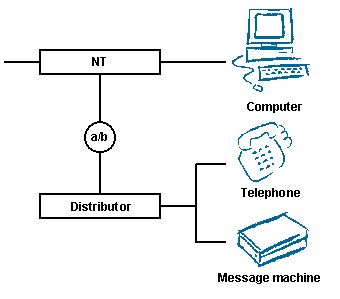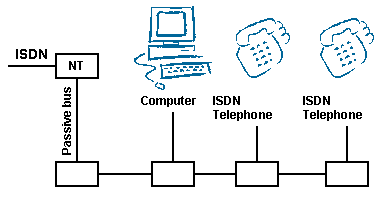|
Technological evolution of the telecommunications world
are introducing to the Virtual
Campus a whole range of new connection possibilities.
The aim of the following sections is to throw light
on the new concepts in order to help you to choose the
configuration that will best suit your needs.
Connection from home to the Virtual Campus can be effected
by means of the following networks: BTN, ISDN, ADSL
and CABLE. Tests have also been conducted to search
for new ways linked to mobile telephony such as the
GPRS (General Packet Radio Service) system. Even though
from a technological standpoint this is a valid option,
it is not an effective one for the UOC's educational
system, owing to the costs involved. In the near future,
new ways will appear, which will be linked to satellite.
The following possibilities are currently available.
| Integrated
Services Digital Network (ISDN) |
 |
What is |
This is the digital technology solution. The technology
of digital transmission allows for the use of the same
network for the transmission of voice, data, images,
etc., instead of using, as has been done up to now,
a specific network for each type of information. The
connection of the PC to the network is effected by means
of an ISDN
adapter* (ISDN card). Unlike the conventional telephone
line, an ISDN line needs a small device at the user's
home end, which in telephone jargon is known as network
adapter*.
A basic ISDN access is made up of three channels, of
which you will use only two. This will allow you to
have your PC connected on one of the channels while
receiving or making telephone calls on the other. This
implies greater availability and will stop your phone
from being engaged while you are using the computer.
 |
Advantages |
It provides the sort of quality and the services which
are impossible to obtain through BTN. On the other hand,
each of these channels works at more speed (64,000 bits
per second), almost twice as fast as a BTN line in most
cases. This implies that the same amount of information
will be obtained in less time, and therefore phone costs
will be lower.
In addition, the quality of digital lines is higher
than that of analogue lines. Thus, the chance of error
in transmissions is reduced.
Finally, it should be noted that in ISDN, the time
involved in connecting the call is less. When calling
the UOC, for instance, you may connect in barely two
seconds, as opposed to the ten seconds involved in BTN.
The sum of all these factors (speed, reliability, and
time of connection of call) supposes important savings
in the phone bill, and a more comfortable way of working.
 |
Drawbacks |
The main drawback of ISDN is that you have to subscribe
at home, which means that staff from Telefónica
will have to come to your home, as when one requests
a new telephone set.
It should be taken into account that Telefónica
cannot yet provide this technology for the whole of
the Spanish territory, so it is possible that you may
still not be able to have an ISDN access at home. Despite
Telefónica's calculations, experience during
these years shows that around 30% of installations have
problems which can delay the proper working of the line
for a number of months.
On an ISDN line you may make and receive phone calls
in the normal way, as with BTN. The difference is that
ISDN incorporates at an identical cost many of the facilities
that BTN bills separately, like the re-routing of a
call, call wait, etc. The cost of calls is identical
for both networks. What is different are the monthly
rates and the initial subscription rate.
Subsequent migration to ADSL with ISDN is more difficult
than with BTN. For example, some operators do not offer
ADSL on ISDN lines.
Possible Configurations at Home
|
ISDN Network for data,
with a/b adapter (makes
use of the former installation for voice) |
 |
| Advantages |
 |
Possibility of working at the Virtual
Campus without the phone being engaged.
|
 |
Speed of transmission, reliability and connection. |
 |
Single line for telephony and connection to
the Campus.
|
 |
Chance of using analogue devices already installed
at home. |
 |
Configuration is cheaper. |
|
| Drawbacks |
 |
You have to subscribe to an ISDN line. |
 |
You have to change your telephone number.
|
 |
Cannot take advantage of ISDN telephony facilities,
such as, call wait, re-routing... |
 |
It is not always available, as it depends
on Telefónica's public central switchboard.
|
 |
Subsequent migration to ADSL with ISDN is
more difficult. |
|
|
An ISDN for data and
a BTN for voice |
 |
| Advantages |
 |
Those proper to ISDN for connection to the
Campus: speed of transmission, reliability,
and time of connection of call. |
 |
Your telephone is not engaged while you are
connected to the Campus.
|
 |
You can keep the same telephone number. |
|
| Drawbacks |
 |
You have to go to all the bother of subscribing
to an ISDN line. |
 |
You have to pay for a second line. |
 |
It does not take advantage of ISDN telephony
facilities such as call wait, re-routing... |
 |
It is not always available, as it depends
on Telefónica's public central switchboard.
|
|
|
An ISDN line with a passive
bus, for both voice and data |
 |
| Advantages |
 |
Your telephone is not engaged while you are
working at the
Campus. |
 |
Those proper to ISDN for connection to the
Campus
(speed of transmission, reliability, and time
of connection of call), and for telephony
(call wait, re-routing...). |
 |
Single line for telephony and connection to
the Campus.
|
|
| Drawbacks |
 |
You have to go to all the bother of subscribing
to an ISDN line. |
 |
You have to change your telephone number.
|
 |
ISDN has no fax or cordless telephone facilities.
|
 |
It is not always available, as it depends
on Telefónica's public central switchboard.
|
 |
Subsequent migration to ADSL with ISDN is
more difficult. |
|
|